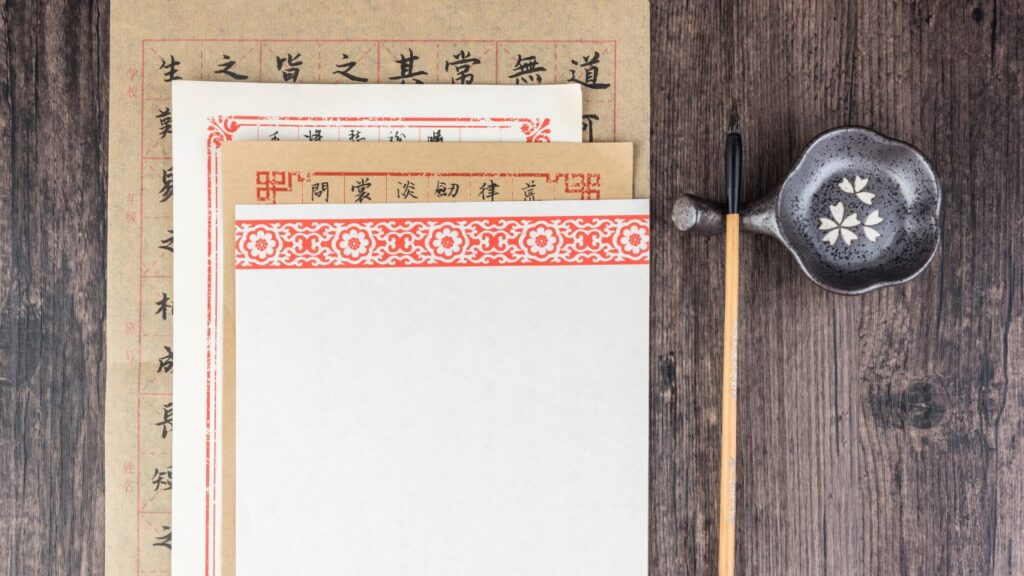Chinese writing is a fascinating and rewarding skill to master, but it can also seem daunting for beginners. With over 50,000 characters, each with stroke order and meaning, how can you learn to write Chinese effectively and confidently?
In this blog post, we will share some simple yet effective tricks to make learning Chinese writing less intimidating and enjoyable. You will learn the basics of Chinese writing, such as radicals and strokes, and techniques to improve your handwriting, such as using tianzige (grid paper), trace paper, and practice books.
You will also discover tips for better Chinese handwriting, such as being careful with horizontal strokes and reading extensively to enhance character recognition. Finally, you will find valuable resources for learning Chinese writing, such as online courses and tutorials, reference books and materials, and language exchange platforms.
Are you ready to conquer those strokes? Let’s dive right in!
Key Takeaways
- Learn the basics of Chinese writing, including radicals and strokes.
- Follow stroke sequences to write characters correctly.
- Use mnemonic devices and regular practice to commit characters to memory.
- Practice strokes, radicals, and characters regularly for better handwriting.
Table of Contents
Understanding the Basics to Write Chinese
Learn the fundamentals of Chinese writing, including identifying and memorizing radicals and strokes and understanding stroke sequences for proper character construction.
Learning radicals and strokes
Chinese writing starts with small parts. These small parts are the radicals and strokes.
- Grasp the meaning of radicals. Radicals hold the key to a Chinese character’s meaning.
- Master basic strokes. Strokes are lines that makeup radicals and characters.
- Learn 20 common radicals first. This helps you identify character meanings.
- There are around 30 different strokes you should know.
- Train your hand to write these strokes in a loose, flowing style.
- Pay attention to where your stroke starts and ends.
- Use the right order when you draw strokes in a radical or character.
Stroke sequences
To write Chinese characters correctly, you need to follow the stroke sequences. Here are some tips to help you:
- Start from the top: Write the character from the top and work your way down.
- Go left to right: After writing the vertical strokes, move on to the horizontal ones, starting from left to right.
- Inside out: When a character has multiple components or radicals, start with the inner parts before moving outward.
- First horizontal strokes: In most cases, write the horizontal strokes before adding the vertical or diagonal ones.
- Be consistent: Practice writing characters in the correct stroke sequence to develop muscle memory and improve your handwriting.
Committing characters to memory
Memorizing Chinese characters can seem overwhelming, but with the proper techniques, it becomes manageable. One important tip is to follow stroke order rules. This means writing characters from top to bottom and left to right, starting with horizontal strokes before vertical ones.
Another helpful trick is practicing radicals and strokes individually before moving on to whole characters. Additionally, using mnemonic devices or creating stories around characters can aid in memory retention.
Consistent practice is critical, whether through daily writing or flashcards and online resources for reinforcement. Following these tips and tricks, you’ll soon become proficient at committing Chinese characters to memory.
Techniques to Improve Chinese Handwriting
Practice strokes, radicals, and characters regularly to improve Chinese handwriting. Use tianzige (grid paper) for better spacing and alignment. Utilize trace paper and practice books for guided practice.
Choose the right pen that feels comfortable to write with. Develop your unique style of writing Chinese characters through daily writing practice in a diary or journal.
Practicing strokes, radicals, and characters
To improve your Chinese writing skills, it’s important to practice strokes, radicals, and characters. Here are some simple techniques you can try:
- Start with basic strokes: Practice the individual strokes used in Chinese characters. Focus on mastering the proper shape and order of each stroke.
- Learn radicals: Radicals are the building blocks of Chinese characters. By learning and practicing common radicals, you’ll be able to recognize and recall characters more easily.
- Memorize characters: To become proficient in Chinese writing, commit characters to memory through regular practice. Break them into smaller components like radicals or repeated strokes to make memorization easier.
- Use tianzige (grid paper): Tianzige is a particular grid paper designed for practicing Chinese characters. It helps maintain proper spacing and proportions while enhancing your overall handwriting.
- Try trace paper and practice books: Trace paper allows you to overlay a transparent sheet on top of model characters, allowing you to trace them for practice. Practice books offer pre-drawn grids for writing practice.
- Choose the right pen: Experiment with different types of pens until you find one that feels comfortable and produces clear lines when writing Chinese characters.
- Write in a diary or journal daily: Set aside time each day to write in a diary or journal using Chinese characters. This regular practice will help reinforce what you’ve learned and improve your writing skills over time.
- Develop your style: As you gain confidence in your writing abilities, don’t be afraid to develop your aesthetic style of writing Chinese characters. Let your personality shine through your handwriting.
Practice with Chinese Writing Workbooks
If you’re looking for the right tools to practice your Chinese writing, you should check out our Chinese writing practice workbooks. Their unique designs and various themes make writing Chinese characters more enjoyable and engaging.
Unlike other workbooks with small and dull squares, our workbooks have large writing areas that make writing Chinese characters more accessible and fun. You can also monitor your progress, learn new words, and practice with different difficulty levels.
Whether you like Mi Zi Ge or Dotted Lines, you’ll find a workbook that matches your style and needs. These Chinese writing practice workbooks are not only beautiful but also functional. Order yours today and start writing like a pro!
Using tianzige (grid paper) for better handwriting
To improve your Chinese handwriting, try using tianzige (grid paper). This type of paper has squares that help you correctly align and space your characters. By practicing on tianzige paper, you can train yourself to write more precisely and consistently.
The grids guide the size and shape of each character, making it easier for beginners to learn stroke order and formation. Regular practice on tianzige paper lets you write Chinese characters more neatly and confidently.
It’s a simple yet effective tool for improving your handwriting skills in Chinese.
Using trace paper and practice books
You can use trace paper and practice books to improve your Chinese handwriting. Trace paper allows you to trace over the strokes and characters, helping you understand their structure and formation.
Practice books provide exercises for repeatedly writing Chinese characters, helping you build muscle memory and improve accuracy. By using these tools regularly, you can develop better control over your brush or pen strokes, leading to neater and more precise handwriting.
So don’t hesitate to incorporate trace paper and practice books into your learning routine!
Choosing the right pen for writing Chinese characters
Picking the right pen for writing Chinese characters is essential to ensure smooth and accurate strokes. A fine-tip pen or a brush pen with flexible bristles is ideal for creating the thin and thick lines needed in Chinese calligraphy.
The ink should be dark and fade-resistant, allowing your characters to stand out on paper. Choosing the right pen can enhance your writing experience and make your Chinese characters look more beautiful and precise.
Daily writing practice in a diary or journal
To improve your Chinese writing skills, it is essential to practice daily. One effective way to do this is by writing in a diary or journal. This allows you to practice forming Chinese characters and helps with vocabulary and sentence construction.
You can gradually build confidence and fluency in writing Chinese by dedicating a few minutes daily to writing about your thoughts and experiences. Additionally, keeping a record of your progress in a diary or journal allows you to track your improvement over time.
Remember, consistency is key when developing any skill, including writing in Chinese.
Developing your aesthetic style of writing
To develop your aesthetic writing style in Chinese, it’s important to practice regularly and pay attention to details. Start by mastering the basic strokes and characters, then move on to experimenting with different styles.
Don’t be afraid to add your personal touch and creativity to your writing. Use resources like trace paper and practice books to refine your skills. Choose a pen that feels comfortable for you, as it can significantly affect the outcome of your handwriting.
Practicing daily in a diary or journal will gradually develop a unique style that reflects your personality. Remember, consistency is key!
Tips for Better Chinese Handwriting
Pay attention to the horizontal strokes when writing Chinese characters, as they can easily be distorted. Practice reading extensively to improve your recognition of characters and enhance your understanding of their construction.
Want more tips for better Chinese handwriting? Keep reading!
Being careful with horizontal strokes
When writing Chinese characters, it is essential to be careful with horizontal strokes. This means paying attention to the direction and shape of these strokes, as they can significantly impact the character’s overall appearance.
Horizontal strokes should be written from left to right with a steady and consistent motion. Proper spacing and alignment between horizontal strokes are essential to ensure clarity and legibility in your writing.
By practicing this technique, you can improve the overall quality of your Chinese handwriting and make your characters more visually appealing. So remember, take your time, be mindful of your stroke direction, and strive for consistency when writing horizontal strokes in Chinese characters.
Reading extensively to enhance character recognition
Reading extensively is an effective way to improve character recognition when writing in Chinese. By exposing yourself to a wide range of texts, such as books, articles, and online resources, you can familiarize yourself with different characters and their meanings.
This helps you better understand the language and enhances your ability to recognize and write Chinese characters accurately. So, make it a habit to read regularly and explore various sources that can provide valuable exposure to the Chinese written language.
Resources for Learning Chinese Writing
Discover the unlimited opportunities for learning Chinese writing through online courses, tutorials, and language exchange platforms. Expand your knowledge with reference books and materials to master stroke order rules and character construction.
Engage in immersive practice to enhance your skills and find inspiration from others. Explore the world of Chinese writing resources today!
Online courses and tutorials
If you want to learn how to write Chinese characters but find the complexity overwhelming, online courses and tutorials are available to help you. These resources provide step-by-step instructions and practice exercises to improve your Chinese writing skills. You can access these courses and tutorials from the comfort of your home, making it convenient for you to learn at your own pace. With the guidance of experienced teachers or native speakers, you can gain confidence in writing Chinese characters correctly and effectively. Take advantage of these online resources to enhance your Chinese handwriting abilities.
Reference books and materials
You can explore various reference books and materials to enhance your Chinese writing skills. These resources are designed to assist you in understanding the complexities of Chinese characters and improving your ability to write them. Here are some recommended options:
- Chinese character dictionaries provide comprehensive lists of characters and their meanings, pronunciations, and stroke order.
- Writing manuals: These guides offer step-by-step instructions on stroke order, character construction, and proper formation.
- Calligraphy books: These showcase different styles of Chinese calligraphy and can serve as inspiration for developing your aesthetic writing style.
- Workbooks: These practice books provide exercises for practicing strokes, radicals, and complete characters.
- Flashcards: These portable study aids allow you to review characters while on the go, helping you memorize them more effectively.
- Online resources: Some many websites and apps offer interactive tools, online courses, tutorials, and practice exercises for learning Chinese writing.
Language exchange platforms
Many online language exchange platforms are available for people who want to practice writing Chinese. These platforms connect language learners with native speakers of Chinese, allowing them to improve their writing skills through conversation and feedback. Some popular language exchange platforms include HelloTalk, italki, and Tandem.
These platforms allow users to connect with native speakers and engage in conversations using text-based messaging or voice/video calls. They also offer features such as language correction, translation tools, and learning resources to support the learning process. By participating in language exchanges on these platforms, learners can practice their writing skills, gain cultural insights, and make new friends.
Read More about Learning Chinese
- What You Need to Know About the Top 20 Chinese Radicals
- How To Learn Chinese Fast For Busy People Online
Conclusion
This article has introduced some essential concepts and methods for improving your Chinese writing skills. You have learned how to understand the basics of Chinese writing, such as radicals, strokes, and stroke sequences. You have also learned to commit characters to memory and practice them regularly.
Moreover, you have learned some techniques to improve your Chinese handwriting, such as using grid paper, trace paper, practice books, and the right pen. You have also learned to develop your aesthetic writing style and express yourself in Chinese.
Finally, you have learned some tips for better Chinese handwriting, such as being careful with horizontal strokes and reading extensively to enhance character recognition.
Additionally, you have learned some resources for learning Chinese writing, such as online courses, reference books, and language exchange platforms. By following these steps and tips, you can master the art of Chinese handwriting quickly.
FAQs
- Is it challenging to learn how to write Chinese?
Learning to write Chinese can be challenging, but with the right tricks and practice, it can become easier over time.
- What are some simple tricks for writing Chinese characters?
Some simple tricks for writing Chinese characters include breaking them down into basic strokes, practicing stroke order, and using mnemonic devices or visual aids to remember the meanings and shapes of characters.
- How long does it take to become proficient in writing Chinese?
The time it takes to become proficient in writing Chinese varies depending on factors such as dedication, frequency of practice, and individual learning abilities. Consistent practice can make progress within a few months to a few years.
- Can I learn to write Chinese without taking formal classes?
You can learn to write Chinese without taking formal classes by utilizing online resources like language learning apps or websites that provide tutorials and exercises specifically for writing Chinese characters.






